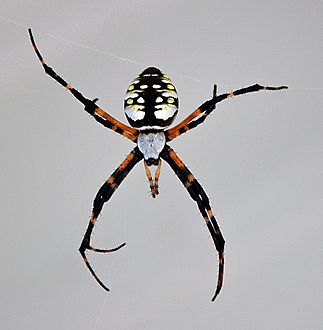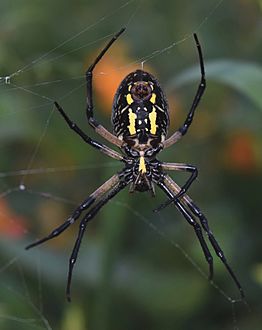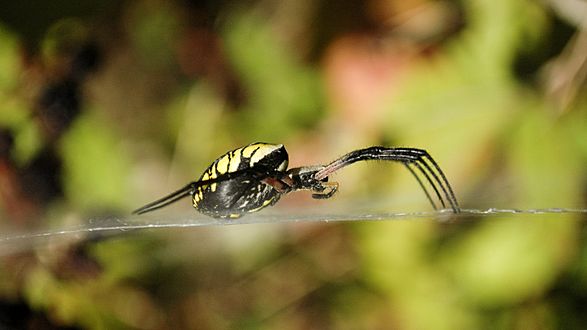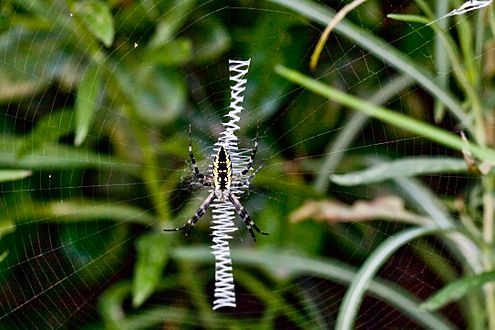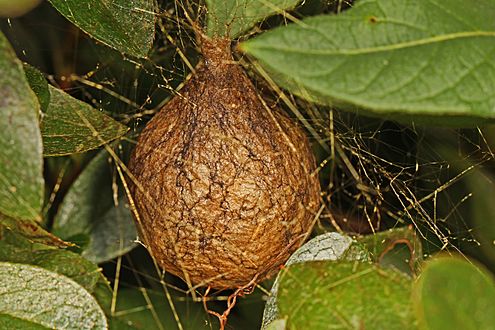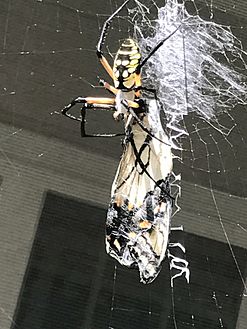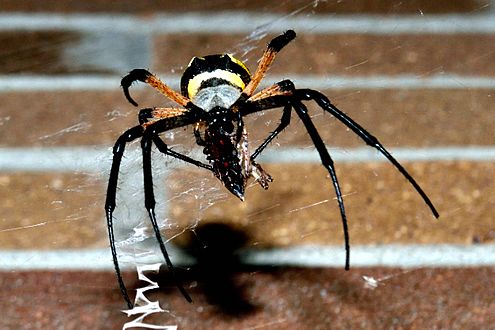Yellow garden spider facts for kids
Quick facts for kids Yellow garden spider |
|
|---|---|
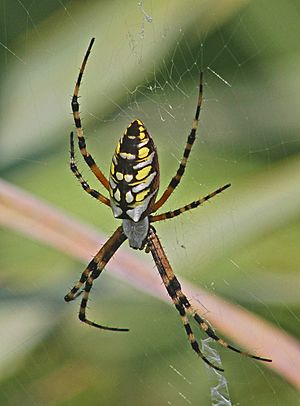 |
|
| Scientific classification | |
| Synonyms | |
|
Nephila vestita |
The yellow garden spider is a common spider found across North America. It is also known by many other names, like the black and yellow garden spider, golden garden spider, or writing spider. This spider was first described in 1833 by Hippolyte Lucas. You can find it in the United States, southern Canada, Mexico, and Central America.
These spiders have bright yellow and black patterns on their bodies. Their scientific name, Argiope aurantia, means "gilded silver-face." This refers to their shiny appearance. Male yellow garden spiders are small, about 5 to 9 millimeters long. Females are much larger, ranging from 19 to 28 millimeters. If disturbed, these spiders might bite. However, their venom is not harmful to most humans. It feels similar to a bumblebee sting.
Contents
Where Yellow Garden Spiders Live
Yellow garden spiders often build their webs in sunny, open areas. They like places where they can hide and be safe from strong winds. You might also spot their webs near house eaves, sheds, or in tall plants.
Female yellow garden spiders tend to stay in one spot for most of their lives. They usually do not move around much once they have built a good web.
The Spider's Amazing Web
The web of a yellow garden spider is easy to spot. It is a large, circular web, often up to 2 feet (60 cm) wide. In the middle of the web, there is a thick, zigzag pattern of silk. This special part is called a stabilimentum. Scientists are not fully sure why spiders build this zigzag. Some think it helps the spider hide in the web's center. Others believe it might attract insects for food. It could also warn birds so they do not fly into the web. Only spiders that are active during the day build these zigzags.
To build its web, the spider first stretches several strong lines between four or five anchor points. These points can be over three feet apart. All these lines meet in the middle. The spider then adds more lines to create a frame. After that, it fills the center with a spiral of silk. It leaves a small gap between each spiral ring. The spider starts from the center and works its way out in a circle. To make the web tight, the spider gently pulls the lines together as it adds the silk spiral.
Female spiders build much bigger webs than males. Male spiders build small zigzag webs, often close to a female's web. The spider usually sits in the center of its web, facing down. It waits for insects to get caught. If a predator comes near, the spider might drop from the web. It will hide on the ground until the danger passes. A web usually stays in the same place all summer. However, spiders might move their webs early in the season. This could be to find a safer spot or better hunting grounds.
Web Shaking and Cleaning
The yellow garden spider can shake its web very fast while staying firmly in the middle. This shaking might help protect it from predators like wasps or birds. It also helps to fully trap an insect before it can escape.
Sometimes, other insects might try to steal food from the web. For example, a European hornet was once seen cutting free prey caught in a yellow garden spider's web. In that case, the spider did not fight the hornet. It simply dropped from the web and hid.
Every night, the spider eats the circular, inner part of its web. Then, it rebuilds this part with fresh silk each morning. The main frame and anchor lines are usually not replaced. By eating the old silk, the spider might be recycling the chemicals used to build the web. Also, the tiny threads it eats may contain small insects and other food particles.
Unlike some other orb-weaving spiders, yellow garden spiders do not live in large groups. They keep their webs clean and organized. Other spiders, like the golden orb web spider, might build many messy webs close together.
Where They Are Found
These spiders are found from Canada all the way down to Costa Rica. However, they are less common in the mountain areas of the Rockies.
Spider Venom
Argiope spiders are not aggressive. They will only bite if they feel threatened, like if someone grabs them. They do not attack large animals for any other reason. Their venom contains special chemicals called polyamine toxins. Scientists are studying these toxins for possible medical uses.
A bite from a yellow garden spider feels similar to a bee sting. It might cause some redness and swelling. For a healthy adult, a bite is usually not a big problem. Even though these spiders are not aggressive, young children, older adults, and people with weak immune systems should be careful around them. This is similar to how they would be careful around a beehive.
Reproduction and Life Cycle
Yellow garden spiders usually breed twice a year. Male spiders travel around looking for a female. They build a small web very close to, or even inside, the female's web. Then, the male tries to get the female's attention by plucking strands on her web. When a male approaches a female, he often has a safety line ready. This is in case she tries to attack him. The male uses special parts on his pedipalps to transfer sperm to the female. After he inserts the second part, the male often dies. Sometimes, the female will then eat him.
The female lays her eggs at night on a sheet of silk. She then covers them with another layer of silk, making a protective brownish sac. She uses her legs to shape this silk into a ball with a small neck. These egg sacs are about 5/8 to 1 inch wide. She often hangs the egg sac right on her web, close to where she usually sits. Each female can make one to four sacs. Each sac can hold over a thousand eggs! She guards her eggs from predators for as long as she can. However, as the weather gets colder, she becomes weaker. She usually dies around the time of the first hard frost.
In the spring, the tiny baby spiders hatch and leave the egg sac. They are so small that they look like dust inside the silk. Some of these spiderlings stay nearby. But many others release a strand of silk into the air. The wind catches this silk, carrying the spiderling to a new, more distant area. This is how they spread out.
What Yellow Garden Spiders Eat
Female yellow garden spiders are the ones you usually see in gardens. Their webs have that unique zigzag silk pattern in the middle. These spiders spend most of their time in their webs. They wait patiently for prey to get stuck. When an insect gets caught, the spider might shake the web. This helps to trap the insect even more. Once the prey is secure, the spider injects its venom to kill it. Then, it wraps the prey in silk. This silk cocoon holds the food for later eating, usually within 1 to 4 hours. Yellow garden spiders eat insects and sometimes even small animals like geckos or green anoles.
Gallery
-
Eating a swallowtail butterfly in Holly Springs, North Carolina
- Yellow garden spider at the Encyclopedia of Life
Images for kids
See also
 In Spanish: Argiope aurantia para niños
In Spanish: Argiope aurantia para niños


